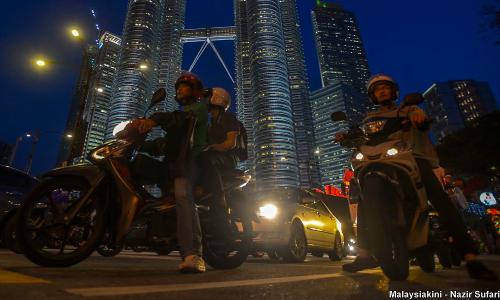Time to phase out the 'killer kapcai'
LETTER | It is argued that the kapcai (small capacity motorcycle or an 'underbone') is considered the number one killing machine or tool for destruction involving kids as early as six years old and young adults up to 25 years old.
Statistics by Royal Malaysian Police have shown that many kids ranging from six to 10 years old were killed for riding a kapcai while teen bikers aged 16 to 20 consistently recorded the highest deaths every year among all age groups for any type of vehicle.
Many underbone bikes below 250cc or commonly known as kapcai today are equipped with a sturdy engine fitted within the underbone of the reduced frame or a simplified wheelbase. A kapcai nowadays is lightweight, economical, fast, nimble and offers good handling.
Unfortunately, these are among the contributing factors for kids and youngsters to speed and ride recklessly. In the first place, they should never be allowed to ride such a fast motorbike.
It breaks my heart to learn about crashes during peak hours and deaths especially among schoolkids due to their recklessness or rather their naivety riding a fast, nimble kapcai.
We can't rely on enforcement all the time. Hence, there is a need to limit the availability of kapcai to youngsters in stages.
For a start, teenagers and young adults from the age of 16 to 25 should only be limited to riding electric motorcycles with a top speed of 70 km/h.
The authorities should make it compulsory that those with 'P' riding licenses are only allowed to ride low-powered electric bikes.
It is estimated, there are nearly 11 million active kapcai on the roads in the country. On average, in the past 12 years, around 4,100 kapcai users perished on our roads annually.
Malaysian Institute of Road Safety Research (Miros) researchers concluded that economic losses from the injuries and deaths involving motorcycle users from 2015 to 2017 were RM18.15 billion.
We need to be bold and we have little choice. Malaysia must retire the kapcai and all motorcycles below 250cc gradually.
I reckon that the phasing out process of the kapcai can be done within a six-year cycle. I believe this can be triggered by introducing additional taxes or non-kapcai friendly policies to discourage their sales.
As a replacement, the country can introduce attractive incentives or a fresh policy package to encourage more low-powered electric motorcycles with a top speed ranging from 60 km/h to 90 km/h. They can be assembled or even manufactured locally to lower their prices.
Electric motorcycles are the future, it is the way forward. This is your chance, Malaysia, to be the hub for electric motorcycle production in the region.
Electric motorbikes are already flooding East Asia and from a safety aspect, the speed of the vehicle can be limited.
Hanoi, with a vast population of eight million, has announced a ban on two-stroke bikes starting 2025 and a complete ban for all types of motorcycles by 2030.
My sources tell me Vietnam is seriously looking to invest in electric motorbikes as an affordable mode of transport to tackle their pollution issue.
Throughout Vietnam, there are around 47 million motorcycles and they are ready to retire low-powered motorbikes gradually over the next seven years.
Imagine our envy to see at least 30 million low-powered electric motorbikes being labelled "Made in Vietnam" and our neighbour becoming the distribution hub for Asean?
Do we want to miss out on this opportunity on the electric vehicle economics shift?
For Malaysia, the proposed retirement of the kapcai is more related to safety and more about the appalling road deaths statistics.
If we phase out the kapcai, it is more about curbing the motorcyclists' attitude of "I-am-always-in-a-rush" during commuting hours and the renowned racing culture of so many kapcai bikers in Penang, Klang Valley, kampung, small towns, etc.
Road safety experts opine that no biker can survive a more than 50 km/h crash impact. The notion is supported by research on the effectiveness of safety helmets by Dr Akira Shibata and Dr Katsuhiro Fukuda from Kurume University's School of Medicine in Japan.
Their research stated that, "(the) helmet is definitely protective at a low speed of 50 km/h but ineffective at high speeds of over 50 km/h."
We must go back to the real purpose of the underbone bike which was to transport people safely from Point A to Point B with travelling speed of below 60 km/h.
I am sure many of us remember the good old days of the Honda 'Cub' series which offered low-speed performance and served us well over short distances. They were not viable for long-distance travel.
If we value nyawa on the road and seriously want to reduce road fatalities especially among the youngsters, Malaysia must decide on the characteristics of affordable motorbikes for the future.
What do we want actually from a kapcai or entry level motorbike in the next 10 years? Do we want the kapcai as a workhorse? Or the kapcai as a racehorse?
I am alone writing this article and pursuing this cause. My conscience is clear. The deep thought about tens of thousands of innocent motorcyclists who have perished on the road over the years keeps lingering on my mind and this spurs me on to complete this humble piece.
The views expressed here are those of the author/contributor and do not necessarily represent the views of Malaysiakini.
RM12.50 / month
- Unlimited access to award-winning journalism
- Comment and share your opinions on all our articles
- Gift interesting stories to your friends
- Tax deductable
